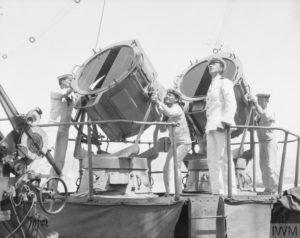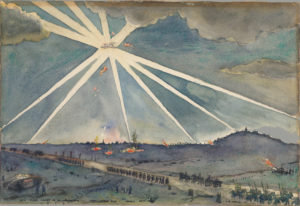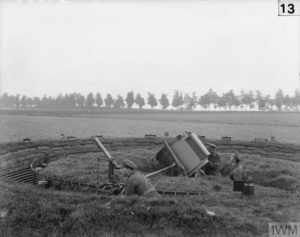Thursday February 28th, 1918
Same as before.
Searchlights
Today’s Battalion diary reports seeing sweeping searchlights on Devedzeli Hill and towards Dojran Lake. Searchlights were successfully used by both sides during the Salonika campaign.

Searchlights were used by the British, on the home front and abroad, to illuminate attacking zeppelins and aeroplane, enabling anti-aircraft batteries to fire on them. The famous downing of the Zeppelin LZ 85 in Salonika Harbour by HMS Agamemnon in May 1916 had been enabled by the searchlights onboard the ship. This photograph shows the searchlight operators recreating the moment (albeit in daylight) when they illuminated the Zeppelin allowing the battleship’s anti-aircraft guns to bring down the airship.


Similarly Lt James Beeney (47 Squadron), an RFC pilot reported being ‘chased..all over the show with searchlights..’ on an impromptu bombing raid over Bulgarian lines in early 1918.¹ This painting is of a similar moment on the Arras-Cambrai Road, France in 1918. It is by a Scottish-born architect, David McAusland Carlile who served with the Canadian Expeditionary Force in WWI.
The last image shows a sophisticated searchlight and emplacement operation in France in May 1918. Note its capacity to rotate and the place names listed around its circumference.
When the Bulgarians were building up their defences on the Dojran front in spring 1917, they positioned 34 searchlights at intervals along their lines in anticipation of a night assault. These did their job during the 1st Battle of Dojran (April/May 1917), ‘silhouetting their attackers against the night sky’² and helping to foil the British advance.
Intelligence Gathering
Sometimes the Battalion diary reads like a series of rather trivial clues in a mystery novel. However, what is reported here is all fed into a larger intelligence-gathering machine. In this way they are revealing the dots that can then, hopefully, be joined together to figure out or at least anticipate what the enemy is up to and has planned.
13th (Service) Battalion War Diary – 28th February 1918 – No 1 Sector, Minden Camp
Our artillery was fairly active all day. In the afternoon and evening enemy artillery was more active than usual on the Sector. This continued until 22:10 hrs. His trench mortar was also more active than usual, firing at intervals throughout the night. Machine guns on both sides were active all night. The enemy fired many Very Lights until the moon came up. At 21:10 a searchlight was active beyond the P ridge probably on Devedzeli Hill. Another was seen to flash into the lake at 21:30 from north east edge. The usual patrols had nothing to report. Enemy is still working hard in the usual places. The 8th KSLI were relieved in No II Sector by the 9th East Lancs and the 9th South Lancs (Vladaja) by the 14th King’s Liverpool Regiment. The 65th MGC relieved the 66th MGC in No 1 Sector. 2 OR are struck off under GRO 1011 with effect from 24-1-18 and 27-2-18. 1 OR having rejoined is again taken on effective strength from 26-2-18.
The health of the Battalion on the whole is good in spite of a cold snap of a week after coming into the line. The main trouble has been sceptic sores in the hands, a peculiarity of the country. There were no cases of frostbite or trench foot.
The effective strength of the Battalion is 32 Officers and 957 other ranks.
Signed, Lieutenant Colonel JFB Morrell, MVO
Commanding 13th (S) Battalion, The Manchester Regt. 1-3-18
References & Further Reading
¹ ‘Under the Devil’s Eye’ by A Wakefield and S Moody (Kindle loc 4651)
² ‘Gardeners of Salonika’ by Alan Palmer, 1965 (page 121-2)
* HMS Agamemnon, Imperial War Museum
# ‘Hun Plane caught in the searchlight‘, Canadian War Museum, 19880007-002
^ Searchlight and Emplacement, Imperial War Museum


